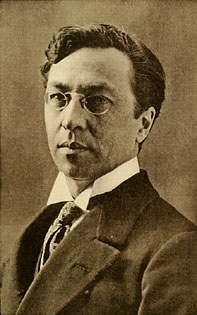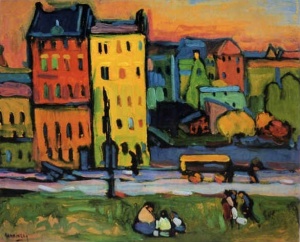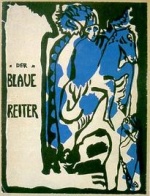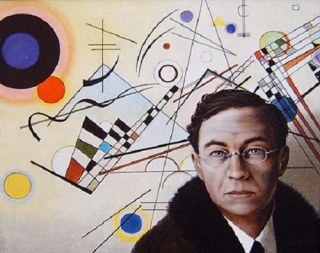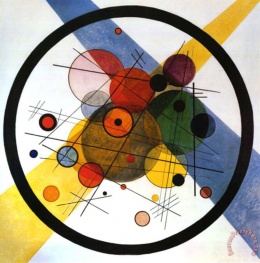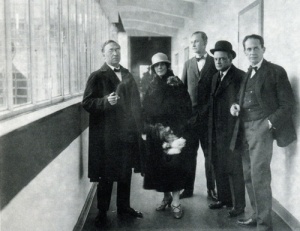Wassily Kandinsky: Difference between revisions
| Line 33: | Line 33: | ||
<blockquote> | <blockquote> | ||
Wassily Kandinsky was an avid student of occult and mystical teachings. Theosophy provided the main structure for his lessons in spirituality, but he certainly enriched his studies with other material. As his spiritual awareness evolved, so too did his art. Ideals that he was previously content to express in Symbolist form, later shed their casings as they expanded through abstraction. As Theosophical teachings on thought forms and the correlation between vibrations, color, and sound influenced his work, he began to rely very little on form. Shape, line, and color became his main tools for creating a visible image of unseen events in the astral world.<ref>Kathleen Hall "Theosophy and the Emergence of Modern Abstract Art" ''Quest'' 90.3 (May-June 2002).</ref> | Wassily Kandinsky was an avid student of occult and mystical teachings. Theosophy provided the main structure for his lessons in spirituality, but he certainly enriched his studies with other material. As his spiritual awareness evolved, so too did his art. Ideals that he was previously content to express in Symbolist form, later shed their casings as they expanded through abstraction. As Theosophical teachings on thought forms and the correlation between vibrations, color, and sound influenced his work, he began to rely very little on form. Shape, line, and color became his main tools for creating a visible image of unseen events in the astral world.<ref>Kathleen Hall "Theosophy and the Emergence of Modern Abstract Art" ''Quest'' 90.3 (May-June 2002).</ref> | ||
</blockquote> | |||
He quoted Blavatsky's [[The Key to Theosophy (book)|''The Key to Theosophy'']] in writing about the methods used by primitive and ancient cultures in dealing with matters that cannot be explained by materialistic science. | |||
<blockquote> | |||
These methods are still alive and is use among nations whom we, from the height of our knowledge, have been accustomed to regard with pity and scorn. To such nations belong the Indians, who from time to time confront those learned in our civilization with problems which we have either passed by unnoticed or brushed aside with superficial words and explanations [such as hypnotism]. Mme. Blavatsky was the first person, after a life of many years in India, to see a connection between these "savages" and our "civilization." From that moment there began a tremendous spiritual movement which today includes a large number of people and has even assumed a material form in the ''Theosophical Society''. This society consists of groups who seek to approach the problem of the spirit by way of the ''inner'' knowledge... Theosophy, according to Blavatsky, is synonymous with ''eternal truth.'' "The new torchbearer of truth will find the minds of men prepared for his message, a language ready for him in which to clothe the new truths he brings an organization awaiting his arrival, which will remove the merely mechanical, material obstacles and difficulties from his path." And then Blavatsky continues, "The earth will be a heaven in the twenty-first century in comparison with what it is now." and with these words ends her book.<ref>Wassily Kandinsky ''Concerning the Spiritual in Art'' (New York: Dover, 1977), 13-14.</ref> | |||
</blockquote> | </blockquote> | ||
Revision as of 04:27, 29 December 2016
UNDER CONSTRUCTION
UNDER CONSTRUCTION
Wassily Kandinsky (Russian: Васи́лий Васи́льевич Канди́нский) was a Russian abstract expressionist painter and Theosophist. He wrote a hugely influential book, Concerning the Spiritual in Art, and taught at the Bauhaus.
Early life and education
Wassily Wassilyevich Kandinsky was born on December 4, 1866 in Moscow. His father, a wealthy tea merchant, was from an aristocratic family. In 1871 Wassily's family moved to the Crimea, and the boy attended school in Odessa. He excelled in his studies, and returned to Moscow in 1886 to study law and political economy. After he was awarded a degree in 1892, he taught jurisprudence at Moscow university. His career path in academia seemed to be well established when he "turned down the offer of a professorship at the University of Dorpat in Estonia and went instead to Munich to study painting."[1] As a young boy he had always loved music and art - playing piano and cello, and painting in oils. "Art and music, ranging from traditional Russian religious icons and Rembrandt oils to a performance of Wagner's Lohengrin, left profound impressions on him... An 1895 Moscow exhibit exposed Kandinsky to the French Impressionists, and his feelings upon seeing Monet's Haystack seemed to predict the destiny that awaited him."[2]
Artistic career
Because young artists in Munich in the 1890s were exploring abstract, primitive, oriental, and medieval styles in the Jugendstil movement, Kandinsky had the opportunity to move in avant-garde art circles while he pursued traditional training. In 1901 he broke away from the academy to form an artists' association called the Phalanx which gave him an outlet for exhibition. He also gained experience in teaching art and built a reputation that helped him into major exhibitions like the 1902 Berlin Secession and the Salon d'Automne in Paris in 1904. He began to travel to Germany, Italy, Holland, Tunisia, and France during 1903-1908, and developed his own style. Back in Munich, "the impact of the Fauvist color, combined with a primitiveness and directness attributable to his Russian heritage, the artist began producing major expressionist landscape paintings." He organized the Neue Künstler Vereinigung [NKV, the New Artists' Association] in a revolt against the Munich Secession. After 1911, his continued movement toward abstraction led to a split in the group, and Kandinsky, with Franz Marc, formed Der Blaue Reiter [the Blue Rider]. They published a journal, called an almanac, that emphasized spiritual reality expressed in diverse styles of art. During this same period, Kandinsky was writing his Über das Geistige in der Kunst, or Concerning the Spiritual in Art, which was published in 1911.[3]
Concerning the Spiritual in Art
Famous paintings
Bauhaus
Theosophical Society involvement
Kandinsky was never a member of any Theosophical society, but read extensively in Theosophical concepts, including the seminal work The Secret Doctrine by Helena Petrovna Blavatsky.
Wassily Kandinsky was an avid student of occult and mystical teachings. Theosophy provided the main structure for his lessons in spirituality, but he certainly enriched his studies with other material. As his spiritual awareness evolved, so too did his art. Ideals that he was previously content to express in Symbolist form, later shed their casings as they expanded through abstraction. As Theosophical teachings on thought forms and the correlation between vibrations, color, and sound influenced his work, he began to rely very little on form. Shape, line, and color became his main tools for creating a visible image of unseen events in the astral world.[5]
He quoted Blavatsky's The Key to Theosophy in writing about the methods used by primitive and ancient cultures in dealing with matters that cannot be explained by materialistic science.
These methods are still alive and is use among nations whom we, from the height of our knowledge, have been accustomed to regard with pity and scorn. To such nations belong the Indians, who from time to time confront those learned in our civilization with problems which we have either passed by unnoticed or brushed aside with superficial words and explanations [such as hypnotism]. Mme. Blavatsky was the first person, after a life of many years in India, to see a connection between these "savages" and our "civilization." From that moment there began a tremendous spiritual movement which today includes a large number of people and has even assumed a material form in the Theosophical Society. This society consists of groups who seek to approach the problem of the spirit by way of the inner knowledge... Theosophy, according to Blavatsky, is synonymous with eternal truth. "The new torchbearer of truth will find the minds of men prepared for his message, a language ready for him in which to clothe the new truths he brings an organization awaiting his arrival, which will remove the merely mechanical, material obstacles and difficulties from his path." And then Blavatsky continues, "The earth will be a heaven in the twenty-first century in comparison with what it is now." and with these words ends her book.[6]
Later years
Additional resources
The Union Index of Theosophical Periodicals lists 9 articles by or about Kandinsky.
- WassilyKandinsky.net offers 511 paintings, 91 photos, biography, books, videos, quotations, and more.
- Wassily Kandinsky Natal Horoscope at Khaldea.
Articles
- Art, Theosophy, and Kandinsky by John Algeo
- Kandinsky's Thought Forms and the Occult Roots of Modern Art by Gary Lachman
- Kandinsky and Theosophy by Catherine Wathen
Video
- Kandinsky, Spiritual Insight, and Abstract Art by Dan Noga
Notes
- ↑ Richard Stratton, "Preface to the Dover Edition" Concerning the Spiritual in Art (New York: Dover, 1972), v.
- ↑ Richard Stratton, "Preface to the Dover Edition" Concerning the Spiritual in Art (New York: Dover, 1972), v.
- ↑ Richard Stratton, "Preface to the Dover Edition" Concerning the Spiritual in Art (New York: Dover, 1972), vi-viii.
- ↑ Mikey Smith, "Wassily Kandinsky: 8 of the Abstract Painter's Most Famous Works and Facts about His Life" Daily Mirror December 16, 2014 on Daily Mirror website.
- ↑ Kathleen Hall "Theosophy and the Emergence of Modern Abstract Art" Quest 90.3 (May-June 2002).
- ↑ Wassily Kandinsky Concerning the Spiritual in Art (New York: Dover, 1977), 13-14.
